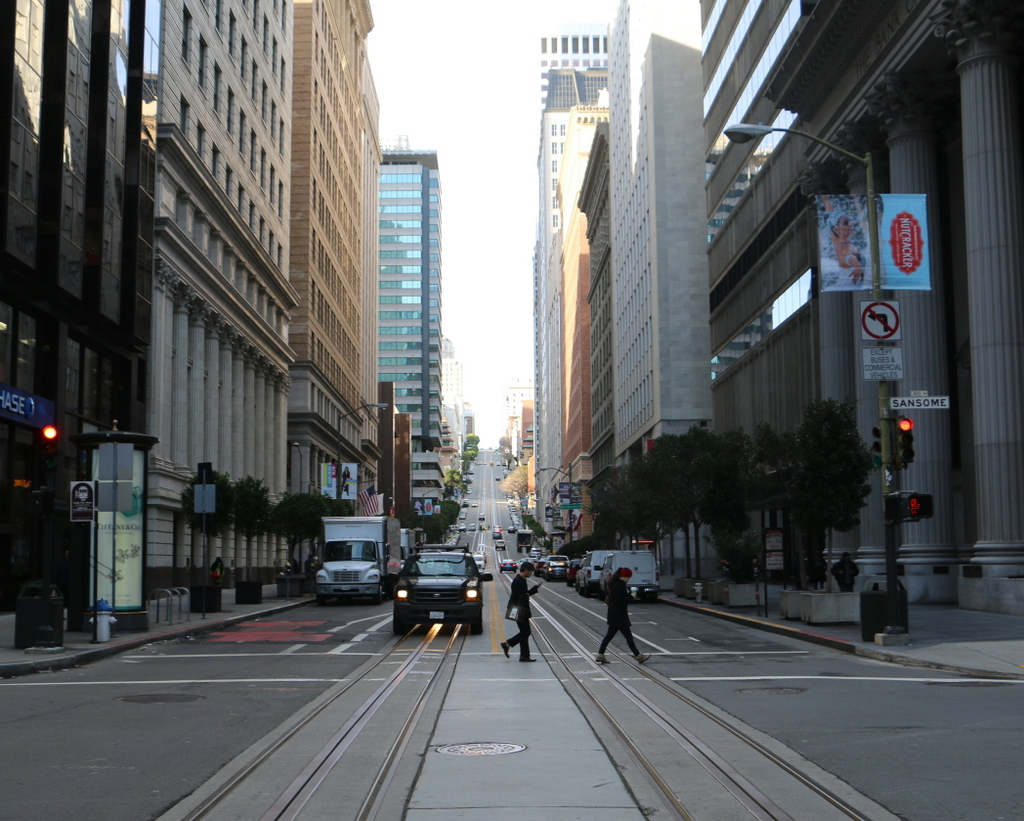Looking down Sacramento Street from near Powell Street in San Francisco, on April 18, 1906. Image courtesy of the Library of Congress, Arnold Genthe Collection.
Sacramento Street in 2015:

The first photo is probably the most famous image from the 1906 San Francisco earthquake, and it was taken by noted photographer Arnold Genthe in the hours that immediately followed the earthquake, before the fires spread across the city. Most of the other post-earthquake images that I have featured here show the city days or weeks after the fires had been put out, when the city was beginning to rebuild. However, this scene shows the disaster as it was still unfolding, as residents stood in the streets and watched the city burn below them.
Years later, Genthe mentioned the photograph in his autobiography, commenting on the almost surreal nature of the scene, with the city burning in the distance and spectators sitting in chairs on the sidewalk, calmly watching as the fire moved closer. He wrote,
“Of the pictures I had made during the fire, there are several, I believe, that will be of lasting interest. There is particularly the one scene that I recorded the morning of the first day of the fire [along Sacramento Street, looking toward the Bay] which shows, in a pictorially effective composition, the results of the earthquake, the beginning of the fire and the attitude of the people. On the right is a house, the front of which had collapsed into the street. The occupants are sitting on chairs calmly watching the approach of the fire. Groups of people are standing in the street, motionless, gazing at the clouds of smoke. When the fire crept up close, they would just move up a block. It is hard to believe that such a scene actually occurred in the way the photograph represents it.”
Perhaps the people in the photo assumed that the fire was too distant to threaten them, but as they were watching the fire department was struggling with broken water mains and limited manpower, and the city government was making poor decisions that, in the coming days, would enable the fire to spread far further than it otherwise may have. By the next day, the fire had moved up the hill, and all of the buildings in the foreground were destroyed.
When the first photo was taken, the bay was not visible because of the dense smoke in the distance. Over a century later, it still isn’t visible from here, because of the tall skyscrapers that have since been built in the Financial District. The cable car line in the first photo was eliminated years ago, and the street is now served by a bus line that runs off of the overhead wires at the top of the 2015 photo. While the buildings from the first photo may be gone, at least one pre-earthquake organization is still here. The brick building partway down the hill on the left side of the photo was the Presbyterian Mission House, a Christian organization that worked to rescue Chinese girls from slavery and sex trafficking. After the earthquake, the organization rebuilt on the same site, and today it is still operated as the Cameron House, named in honor of Donaldina Cameron, who was the superintendent at the time of the earthquake.
This post is part of a series of photos that I took in California this past winter. Click here to see the other posts in the “Lost New England Goes West” series.











